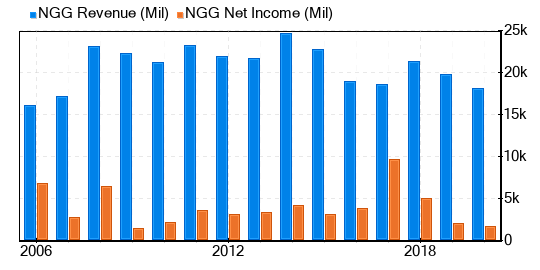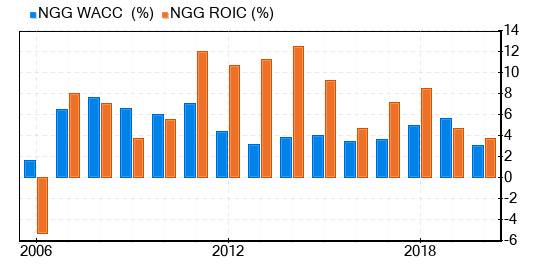National Grid PLC Stock Shows Every Sign Of Being Fairly Valued
- By GF Value
The stock of National Grid PLC (NYSE:NGG, 30-year Financials) is estimated to be fairly valued, according to GuruFocus Value calculation. GuruFocus Value is GuruFocus' estimate of the fair value at which the stock should be traded. It is calculated based on the historical multiples that the stock has traded at, the past business growth and analyst estimates of future business performance. If the price of a stock is significantly above the GF Value Line, it is overvalued and its future return is likely to be poor. On the other hand, if it is significantly below the GF Value Line, its future return will likely be higher. At its current price of $62.52 per share and the market cap of $44.4 billion, National Grid PLC stock appears to be fairly valued. GF Value for National Grid PLC is shown in the chart below.

Because National Grid PLC is fairly valued, the long-term return of its stock is likely to be close to the rate of its business growth, which averaged 1.7% over the past three years and is estimated to grow 2.02% annually over the next three to five years.
Link: These companies may deliever higher future returns at reduced risk.
Investing in companies with poor financial strength has a higher risk of permanent loss of capital. Thus, it is important to carefully review the financial strength of a company before deciding whether to buy its stock. Looking at the cash-to-debt ratio and interest coverage is a great starting point for understanding the financial strength of a company. National Grid PLC has a cash-to-debt ratio of 0.05, which is worse than 82% of the companies in the industry of Utilities - Regulated. GuruFocus ranks the overall financial strength of National Grid PLC at 4 out of 10, which indicates that the financial strength of National Grid PLC is poor. This is the debt and cash of National Grid PLC over the past years:

Companies that have been consistently profitable over the long term offer less risk for investors who may want to purchase shares. Higher profit margins usually dictate a better investment compared to a company with lower profit margins. National Grid PLC has been profitable 10 over the past 10 years. Over the past twelve months, the company had a revenue of $18.7 billion and earnings of $2.642 a share. Its operating margin is 22.10%, which ranks better than 72% of the companies in the industry of Utilities - Regulated. Overall, the profitability of National Grid PLC is ranked 7 out of 10, which indicates fair profitability. This is the revenue and net income of National Grid PLC over the past years:

Growth is probably the most important factor in the valuation of a company. GuruFocus research has found that growth is closely correlated with the long term performance of a company's stock. The faster a company is growing, the more likely it is to be creating value for shareholders, especially if the growth is profitable. The 3-year average annual revenue growth rate of National Grid PLC is 1.7%, which ranks in the middle range of the companies in the industry of Utilities - Regulated. The 3-year average EBITDA growth rate is 0.8%, which ranks in the middle range of the companies in the industry of Utilities - Regulated.
Another method of determining the profitability of a company is to compare its return on invested capital to the weighted average cost of capital. Return on invested capital (ROIC) measures how well a company generates cash flow relative to the capital it has invested in its business. The weighted average cost of capital (WACC) is the rate that a company is expected to pay on average to all its security holders to finance its assets. When the ROIC is higher than the WACC, it implies the company is creating value for shareholders. For the past 12 months, National Grid PLC's return on invested capital is 3.60, and its cost of capital is 2.17. The historical ROIC vs WACC comparison of National Grid PLC is shown below:

Overall, The stock of National Grid PLC (NYSE:NGG, 30-year Financials) shows every sign of being fairly valued. The company's financial condition is poor and its profitability is fair. Its growth ranks in the middle range of the companies in the industry of Utilities - Regulated. To learn more about National Grid PLC stock, you can check out its 30-year Financials here.
To find out the high quality companies that may deliever above average returns, please check out GuruFocus High Quality Low Capex Screener.
This article first appeared on GuruFocus.

 Yahoo Finance
Yahoo Finance 